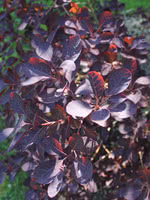Mon-Fri 9am - 5pm Mountain time
Western Snowberry vs Royal Purple Smokebush
Symphoricarpos occidentalis
Cotinus coggygria Royal Purple
NOT AVAILABLE THIS SEASON - MIGHT RETURN
NOT AVAILABLE THIS SEASON - MIGHT RETURN
Like the Common Snowberry, the Western Snowberry is a small shrub with pink flowers useful for feeding livestock and preventing erosion. Unlike the common species, however, the Western Snowberry is much more suited to wet conditions, capable of persevering through poor soil drainage and occasional flooding.
After the Snowberry's flowers have bloomed, it produces berries which often last on the plant through winter. These berries are toxic to humans, but livestock and local wildlife love them! Those hoping to attract wildlife to their property can plant Snowberry and expect to see animals foraging on it much later in the year than other plants.
Royal Purple Smokebush is an attractive and dramatic shrub. Mid-summer you'll notice feathery, purple-pink puffs of airy seed clusters that give the illusion of smoke. The contrast of these seed clusters against deep purple-red foliage will make Royal Purple Smokebush your new favorite shrub.
It is tolerant of clay soil, drought, and deer, making Royal Purple Smokebush a hardy addition to any yard. Try it in a hedge, shrub border, or as an accent shrub; regardless of how you use it, this shrub will be a head turner.
Western Snowberry Quick Facts
Royal Purple Smokebush Quick Facts
Toxicity: berries are toxic to humans

